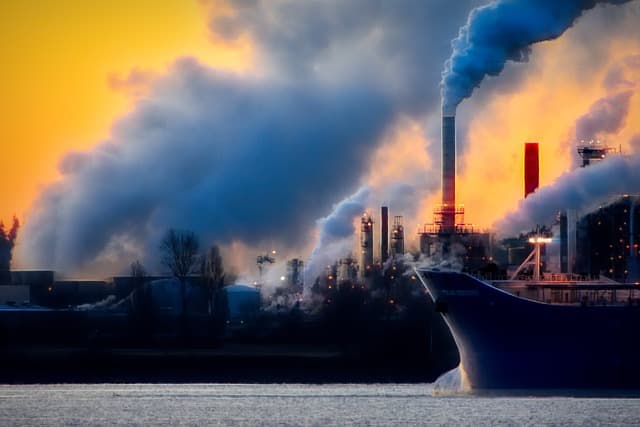Air pollution is a major cause of global environmental threat. The International Labor Organization defines air pollution as the presence in the air of substances that are harmful to health or dangerous for other reasons, regardless of their physical form. The burning of fossil fuels, agricultural activities, and mining are just some of the causes of air pollution. The most common and most polluting pollutants are: carbon dioxide, sulfur dioxide, nitrogen oxides, and dust.
Sources of air pollution
All kinds of substances pollute the air: gaseous, solid and liquid, if they are contained in quantities exceeding their average content. Air pollution is divided into dust and gas pollution. The World Health Organization defines polluted air as such if its chemical composition can adversely affect human, plant and animal health as well as other elements of the environment (water, soil). Air pollution is the most dangerous of all types of pollution because it is mobile and can contaminate virtually all components of the environment over large areas.
The main sources of air pollution are:
- Industrialization and growing population,
- energy industry,
- transportation industry,
- natural sources.
The growing demand for energy has made the burning of hydrocarbons the main source of anthropogenic air pollution.
What is air pollution?
The most dangerous air pollutants are:
- sulfur dioxide (SO2),
- nitrogen oxides (NxOy),
- coal dust (X2),
- volatile organic compounds (benzapyrene)
- carbon monoxide (CO)
- carbon dioxide (CO2),
- tropospheric ozone (O3),
- lead (Pb),
- suspended dust.
Anthropogenic sources of air pollution include:
- low-altitude emissions,
- chemical fuel conversion,
- extraction and transportation of raw materials,
- chemical industry,
- processing industry,
- metallurgical industry,
- cement production,
- landfills for raw materials and waste,
- motorization.
Natural sources of air pollution:
- volcanic eruptions,
- chemical weathering of rocks,
- forest and prairie fires,
- lightning,
- cosmic dust,
- biological processes.
Contaminated air is absorbed by people mainly during breathing. It contributes to respiratory diseases, allergies, and reproductive disorders. In the human household, air pollution causes corrosion of metals and building materials. It also negatively affects plant life by disrupting photosynthesis, transpiration, and respiration. Contaminated air also degrades water and soil. Globally, air pollution affects climate change. Air pollution also increases the acidity of drinking water. It causes an increase in lead, copper, zinc, aluminum, and even cadmium in the water that comes into our apartments. Water with increased acidity destroys plumbing systems by leaching various toxic substances from them.
There are three main types of emission sources:
Point sources – these are mostly large industrial plants that emit dust, sulfur dioxide, nitrogen oxide, carbon monoxide, and heavy metals; area (dispersed) – these are household boilers and furnaces, local boilers, small industrial enterprises, emitting mainly dust and sulfur dioxide; linear – these are polluting sources that have a large extent. Responsible for emissions of nitrogen oxides, carbon monoxides, aromatic hydrocarbons, heavy metals (primarily lead from ethyl, now platinum, palladium and rhodium from automotive catalysts).
Consequences of air pollution include:
Acid rain is precipitation with a low pH. They contain sulfuric acid, formed in an atmosphere contaminated with sulfur oxides from the burning of sulfated coal, and nitric acid, formed from nitrogen oxides. According to some information, acid rain increases infant mortality and the risk of lung disease, as well as acidifying rivers and lakes, destroying flora and fauna, degrading soils, and destroying monuments and architecture.
Smog – polluted air containing a high concentration of dust and toxic gases, the source of which are mainly cars and industrial plants.
Stink (bad smells) – the result of pollutants in the air, which irritate the olfactory receptors. Most often the stench is a mixture of a large number of different compounds present in very small quantities. The impact of unpleasant smells on human health is usually psychosomatic. Solving the problem of air pollution associated with unpleasant odors requires the use of special analytical methods (sensory analysis, olfactometer).
Ozone holes – reduction of ozone (O3) content at an altitude of 15-20 km. The rate of decrease is about 3% per year. Of greatest importance in this process are chlorofluorocarbons (freons), of which the released chlorine (under the influence of ultraviolet radiation) attacks ozone molecules, resulting in the release of oxygen (O2) and chlorine(II) oxide (ClO). The rate of global decrease in stratospheric ozone levels due to human activities (excluding Antarctica), estimated from satellite studies, is 0.4-0.8% per year in the northern temperate latitudes and less than 0.2% in the tropics. The ozone layer is a natural filter that protects living organisms from harmful ultraviolet radiation. In 1995, the Nobel Prize in Chemistry was awarded for research into the effects of freons on atmospheric ozone, and for research into the formation and reactions of atmospheric ozone.
The greenhouse effect is a phenomenon occurring in the planet’s atmosphere that causes the temperature of the planet, including the Earth, to rise. The effect is caused by atmospheric gases called greenhouse gases, which limit heat radiation from the Earth’s surface and lower atmosphere to space.
Air pollution caused by cars is responsible for about 1/4 of the deaths in major cities.
